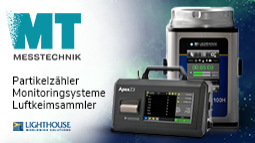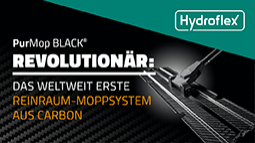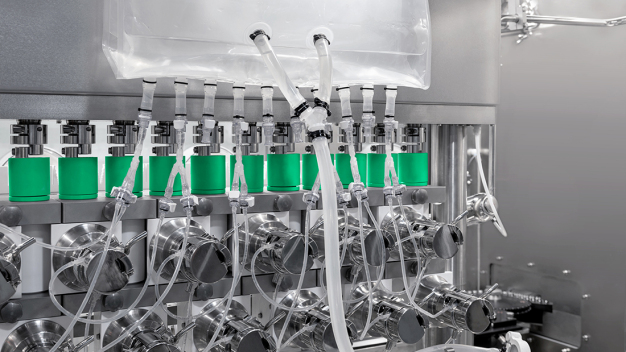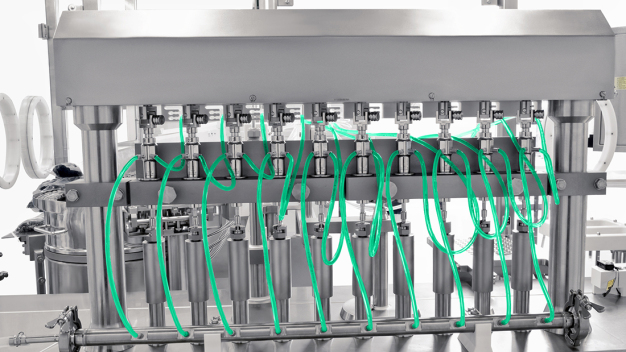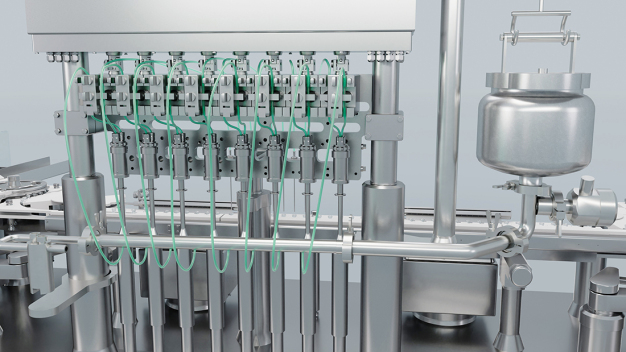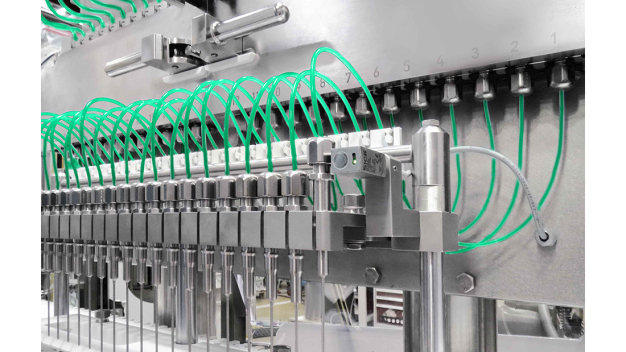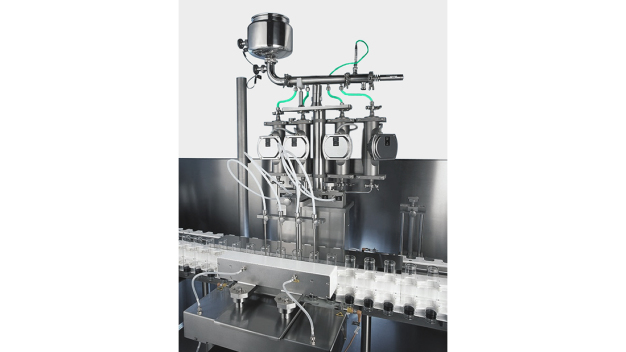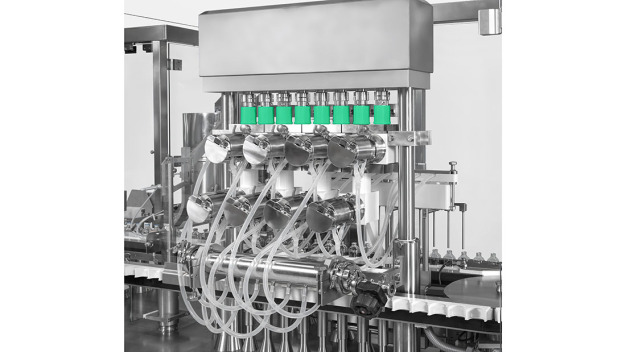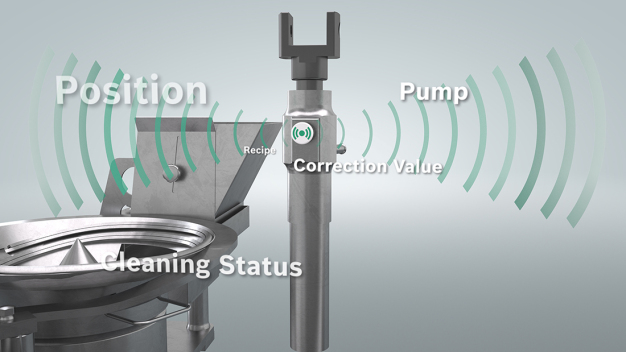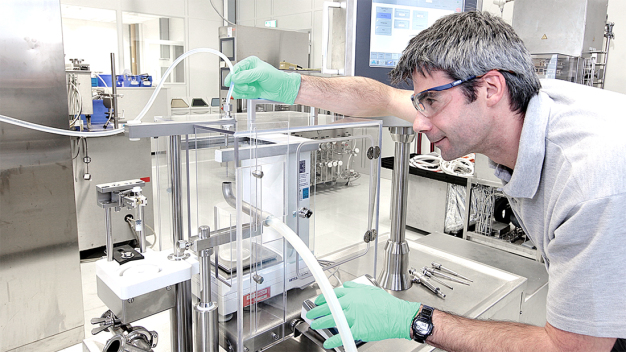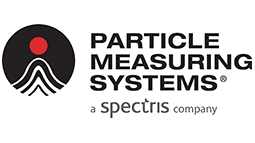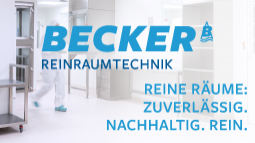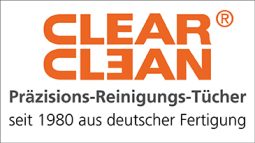- Produkte, Geräte, Systeme, Anlagen für Anwendungen
Sarah Springer
Auf das richtige Füllsystem kommt es an
Effiziente Abfüllung flüssiger Pharmazeutika
Hochpotente, viskose oder flüssige Medikamente oder Suspensionen – produzierende Pharmaunternehmen und Lohnabfüller müssen eine Vielzahl an Produkten in unterschiedlichste Behältnisse abfüllen. Ausschlaggebend für die effiziente und sichere Abfüllung ist die Wahl des richtigen Füllsystems. Dafür braucht es einen Partner, der sowohl eine große Auswahl bietet als auch bei der genauen Abstimmung auf das jeweilige Produkt unterstützen kann.
Die Bandbreite von am Markt erhältlichen Arzneimitteln ist so groß wie noch nie: Auf der einen Seite bleibt der Bedarf an Blockbustern und Generika ungebrochen. Arzneimittel wie Blutverdünner, Schmerzmittel oder Insulin sind aus dem Apothekenregal nicht mehr wegzudenken. Hinzu kommen neue Entwicklungen wie das Inkretinmimetikum Semaglutid, das in den letzten Jahren in der Behandlung von Übergewicht und Diabetes stark an Popularität gewonnen hat.
Auf der anderen Seite zeigt die zunehmende Verbreitung von Arzneimitteln für neuartige Behandlungen (advanced therapy medicinal producuts, ATMPs) wie Zell- und Gentherapien sowie biotechnologisch bearbeitete Gewebeprodukte, dass die Branche sich stetig spezialisiert. Immer individuellere Therapieansätze stellen neue Herausforderungen an die Abfüllung von Klein- und Kleinstchargen. Doch welches Füllsystem ist für welches Produkt das richtige?
Peristaltikpumpe: besonders für Single-Use-Anwendungen geeignet
Eine seit Langem im Markt bekannte und viel genutzte Technologie ist die Peristaltikpumpe. Sie ist besonders leicht zu handhaben: Da sie mit Ausnahme der Schläuche keine Formatteile benötigt, lässt sie sich mit einer Hand bedienen. Die produktschonende Arbeitsweise und präzise Dosierung machen die Pumpe ideal für den Einsatz bei scherempfindlichen Produkten und in Barrieresystemen gemäß des EU GMP Annex 1. Die Peristaltikpumpe kann fest installiert werden, eignet sich aber auch besonders für Single-Use-Anwendungen, da Schlauch und Nadel sehr leicht eingebracht und ausgetauscht werden können. Darüber hinaus steht die Peristaltikpumpe für maximale Produktausbeute, die gerade bei hochpreisigen Biopharmazeutika und Kleinstmengen im Vordergrund steht.
Drehschieberkolbenpumpe: simpel, kostengünstig und robust
Noch weiterverbreitet als die Peristaltikpumpe ist die äußerst flexible Drehschieberkolbenpumpe. Als einfache, kostengünstige und robuste Abfülltechnologie erfreut sie sich seit vielen Jahren großer Beliebtheit in zahlreichen Einsatzbereichen. Das volumetrische Funktionsprinzip gewährleistet eine hohe Dosiergenauigkeit. Im Gegensatz zur Peristaltikpumpe ist die Drehschieberkolbenpumpe auch für wässrige und hochviskose Flüssigkeiten wie Botox oder Hyaluronsäure geeignet. Neben der Edelstahlausführung ist die Pumpe als Keramikvariante für extreme Temperaturbereiche erhältlich. So lassen sich heiße und abrasiv wirkende Produkte schonend abfüllen.
Rollmembranpumpe: aus den USA nach Europa
Ebenfalls perfekt für die Abfüllung empfindlicher Biopharmazeutika eignet sich die Rollmembranpumpe. Sie vereint die Vorteile der Peristaltik- und Drehschieberkolbenpumpe: schonendes Produkthandling dank fehlender Scherkonturen in Kombination mit der Dosierpräzision eines volumetrischen Füllsystems. Das innovative Konzept sorgt mittels einer flexiblen Membran für eine schonende Produktförderung durch den Kolben und den Pumpenkörper. Bislang wird diese Technologie vorrangig in Nordamerika für die Abfüllung kostenintensiver Produkte aus dem Biotech-Bereich angewendet, ist jetzt aber auch in verschiedenen Baugrößen für zwischen zwei und 250 Millilitern in Europa erhältlich. Als großer Vorteil erweist sich dabei neben der CIP/SIP- und Edelstahlvariante die Ausführung als Einwegtechnologie.
Zeit-Druck-Füllsystem: kompakt mit wenigen beweglichen Teilen
Ist hingegen, wie etwa bei der hochvolumigen Abfüllung von Insulin oder neuer Semaglutide in Karpulen, eine Kombination aus hoher Leistung und einer großen Anzahl an Füllstellen mitsamt Barrieresystemen gefordert, bietet sich das Zeit-Druck-Füllsystem an: Die platzsparende Bauweise mit sehr guter Zugänglichkeit und einfachen Formatwechseln ermöglicht eine präzise und produktschonende Abfüllung. Dafür sorgt nicht zuletzt das Minimum an beweglichen mechanischen Teilen. So einfach die Mechanik, so intelligent sind die Regelalgorithmen, die den Produktverlust auf ein absolutes Minimum reduzieren. Das Zeit-Druck-Füllsystem ist für viskose Produkte nicht zu empfehlen, dafür eignet es sich umso mehr für schersensitive Produkte.
Masse-Durchfluss-System für die Heiß- und Kaltabfüllung
Ähnlich arbeitet auch das Masse-Durchfluss-System. Es verwendet die gleichen Komponenten wie das Zeit-Druck-Füllsystem und eignet sich insbesondere für Sonderanwendungen wie die Abfüllung hochpotenter Zytostatika. Der einzige Unterschied besteht darin, dass die Regelung des Füllvorgangs über einen Durchflussmesser statt über Zeitdruck erfolgt. Ein nach dem Coriolis-Prinzip arbeitender Masse-Durchfluss-Sensor in jedem Füllstrang gewährleistet eine unmittelbare 100% In-Prozess-Kontrolle (IPK) und sichert präzise Füllvorgänge. Durch diese hochentwickelte Sensorik ist das System in der Lage, anspruchsvolle Anwendungen wie Heiß- und Kaltabfüllungen zu bewältigen und wird bevorzugt zum Beispiel bei Röntgenprodukten eingesetzt.
Kombifüllstation: mehrere Füllstationen auf einer Maschine
Bei der wachsenden Anzahl pharmazeutischer Flüssigkeiten und immer häufigeren Produktwechseln stehen produzierende Unternehmen und Lohnabfüller vor ganz neuen Herausforderungen: Wie lassen sich verschiedene Produkte mit unterschiedlichen Eigenschaften effizient und platzsparend abfüllen? Die Antwort bieten Kombifüllstationen, die dank der Kombination mehrerer Füllsysteme auf einer Maschine für höchste Flexibilität sorgen und die Produktionslinie jederzeit anpassbar machen. Je nach Bauart sind bis zu vier gängige Füllsysteme möglich, die sowohl in der Edelstahlvariante als auch für Single-Use-Systeme für unterschiedliche Packmittel eingesetzt werden können.
Smart Pump: Füllsysteme werden intelligent
Wie bei allen Produktionsprozessen wird die Frage nach der Transparenz auch beim Füllvorgang immer wichtiger. Neueste Optionen und Zusatzfunktionalitäten sorgen dafür, dass beispielsweise die pumpenspezifischen Parameter wie Reinigungsstatus, Seriennummer und Korrekturwert mittels Lesegerät und modernster RFID-Technologie an die Füllmaschine übertragen werden. Das Bedienpersonal kann die visualisierten Daten auf dem HMI der Maschine komfortabel und prozesssicher ablesen. So tragen neue digitale Lösungen zu höchster Präzision und Transparenz im Abfüllprozess bei und eröffnen zudem neue Möglichkeiten für die vorausschauende Wartung.
Funktionalitäten für eine maximale Produktausbeute
Weitere Funktionalitäten in der Abfülltechnologie fokussieren sich insbesondere auf immer kostspieligere, spezialisierte Medikamente wie zum Beispiel Blutplasmaderivate. Hier steht die hohe Produktausbeute im Vordergrund. So lassen sich etwa mittels sogenanntem Micro-Dosing während des An- und Abfahrvorgangs Behältnisse sehr genau verwiegen und befüllen. Bei Hochleistungsmaschinen können die letzten fünf Prozent des Produkts mit einer sehr kleinen Füllnadel noch präziser und in engeren Toleranzgrenzen dosiert werden, damit auch bei schnellen Füllvorgängen maximale Füllgenauigkeit erzielt wird. Darüber hinaus lassen sich auch im laufenden Füllvorgang Verluste verhindern: Ist ein Behältnis unterfüllt, wird der Prozess kurz gestoppt und auf die Füllstelle zurückgefahren. So muss am Ende kein Behältnis wegen zu geringer Füllmenge aussortiert werden.
Unterstützung bei der richtigen Wahl
Welches Füllsystem das richtige ist und welche Optionen sich zusätzlich für ein bestimmtes Produkt eignen, ist bei der Vielzahl an Möglichkeiten oft die schwierigste Frage. Hier können Systemanbieter wie Syntegon mit umfassendem Service und fundierter technologischer sowie pharmazeutischer Expertise unterstützen. So profitieren Pharmazeuten von umfangreichen Versuchen mit ihren realen Produkten in den Syntegon Laboren – vom spezifischen Test eines ausgewählten Füllsystems über die Silikonisierung von Produkten und Stopfensetzversuchen für Spritzen bis hin zum Vergleichstest unterschiedlicher Füllsysteme.
Auch bei einer Portfolioerweiterung um neue Medikamente oder veränderten Ausbringungsmengen lässt sich die beste Option für eine Nachrüstung oder Umstellung des Füllsystems identifizieren und umsetzen – zum Beispiel von Edelstahl auf Keramik oder auf eine Kombifüllstation mit Einwegfüllsystem inklusive Pumpentrolley. Darüber hinaus sind unterschiedlichste Formatsätze für die Nachrüstung einer Bestandsanlage sowie umfangreiches Zubehör für die unterschiedlichen Füllsysteme verfügbar. Gemeinsam mit den Kunden ermitteln die Expertinnen und Experten von Syntegon die ideale Lösung für jegliche Produkteigenschaften. Denn eins ist sicher: Für die effiziente Abfüllung flüssiger Pharmazeutika ist die Wahl des richtigen Füllsystems entscheidend.
![]()
Syntegon Technology GmbH
Blaufelder Straße 45
74654 Crailsheim
Deutschland
Telefon: +49 7951 4020
eMail: packaging-ph@syntegon.com
Internet: http://www.syntegon.com
